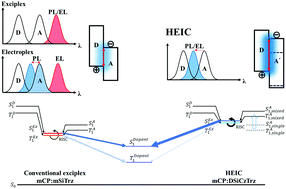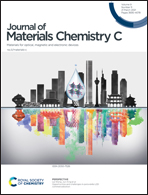Extremely superb efficiency and lifetime of deep blue phosphorescent OLEDs by introducing a hypsochromic emissive intermolecular complex (HEIC) with a negligibly small ΔEST and fast reverse intersystem crossing rate†
Abstract
Extremely superb device performances were realized with 9-(4,6-bis(3-(triphenylsilyl)phenyl)-1,3,5-triazin-2-yl)-9H-carbazole (DSiCzTrz), a newly-synthesized n-type host with high triplet energy. By balancing donor–acceptor characteristics in a single molecule with carbozole and triazine, nearly zero ΔEST of 0.006 eV was observed. Interestingly, upon mixing DSiCzTrz with a p-type host, 1,3-bis(N-carbazolyl)benzene (mCP), a hypsocrhomic emissive intermolecular complex (HEIC), which was significantly blue-shifted from electroluminescence with photoluminescence spectra of DsiCzTrz, was observed. The origin of HEIC was comprehensively investigated and it was found that the effective energy gap between mCP and DSiCzTrz was significantly increased by 0.65 eV. The increase of the energy gap in the mixed system was attributed to the fact that the rotational motion of the carbozole unit in DSiCTrz was highly suppressed in the complex matrix, leading to destabilization of molecular orbitals of DsiCzTrz. In the deep blue phosphorescent OLED (PhOLED) with mCP:DSiCzTrz, 25.6% of external quantum efficiency, ∼115 h of LT50 at 500 cd m−2 which is 100 times longer than the lifetime of the mCP reference device, and a small roll-off of 25% at 10 mA cm−2 were simultaneously achieved. Such superb device performances were comprehensively understood in terms of the negligibly small ΔEST of 0.03 eV and a fast reverse intersystem crossing rate (kRISC) of 1.89 × 106 s−1 in mCP:DSiCzTrz. To the best of our knowledge, this result is the fastest kRISC for a mixed host for deep blue PhOLEDs. Thanks to fast kRISC, triplets were rapidly upconverted into singlets and triplet-polaron quenching was significantly suppressed, consequently leading to high efficiency, long lifetime, and small roll-off simultaneously.



 Please wait while we load your content...
Please wait while we load your content...